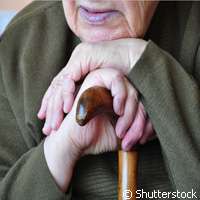Genetic risk factors for restless legs syndrome identified

An international research team has discovered the genetic risk factors for restless legs syndrome (RLS), a disorder that triggers unpleasant sensations in people's legs at night. The study, presented in the journal PLoS Genetics, highlights how carriers of risk variants have a stronger chance of developing RLS. Researchers say the findings could help fuel more investigations on this disorder, potentially leading to new and improved treatment methods.
Restless legs syndrome is a sensorimotor disorder that affects up to 10% of the general population aged 65 and over. While less common, children are also affected by the disease. Besides the unpleasant sensations affecting the lower limbs of their bodies, sufferers have the urge to move when they are resting in the evening or at night. The paraesthesia includes tingling, prickling and numbness. Only when they move their legs, or even get up to walk, do they feel some relief from their discomfort. The downside of moving their legs or walking is a triggering of sleeping disorders, chronic sleep loss and even daytime fatigue. Some patients with very severe cases are reported to suffer from depression and social isolation.
"RLS has been associated with iron deficiency, and is pharmacologically responsive to dopaminergic substitution. Increased cardiovascular events, depression, and anxiety count among the known co-morbidities," the authors write, describing the medical risks posed to patients.
German researchers from the Institute of Human Genetics, Helmholtz Zentrum München and the Technische Universität München (TUM) have been investigating the origin of RLS for several years. Their main objective has been to boost diagnostics and offer innovative treatment solutions. In this latest study, headed by Professor Winkelmann at the TUM Institute of Human Genetics, the German group along with colleagues from Austria, Canada, the Czech Republic, Finland, France, Germany and the United States, assessed over 4 800 patients diagnosed with RLS and 7 280 control patients, all of European ancestry.
Genetic sequence variants (SNPs) distributed over the entire genome were analysed, and the consortium identified two new genetic regions that contribute to the development of this disorder. The genome-wide association (GWA) studies found genetic risk factors with MEISI, BTBD9, PTPRD and 'a locus encompassing MAP2K5 and SKOR', the researchers say.
"To identify additional RLS susceptibility loci, we undertook an enlarged GWA in a German case control population, followed by replication in independent case control samples originating from Europe, the United States, and Canada," the authors write. "In doing so, we identified six RLS susceptibility loci with genome-wide significance in the joint analysis, two of them novel: an intergenic region on chromosome 2p14 and a locus on 16q12. The top six loci show effect sizes between 1.22 and 1.77 and risk allele frequencies between 19% and 82%, and reveal genes in neuronal transcription pathways not previously suspected to be involved in the disorder."
One of the regions is found within a gene that influences brain activity regulation, TOX3. Experts are aware that increased TOX3 protein safeguards neuronal cells from cell death, but the specific association between TOX3 and RLS is still a mystery. The findings of this study could help scientists probe the underlying mechanisms, which in turn could result in new treatment methods.
For more information, please visit:
PLoS Genetics: www.plosgenetics.org/home.action
More information: Winkelmann, J., et al. (2011) 'Genome-Wide Association Study Identifies Novel Restless Legs Syndrome Susceptibility Loci on 2p14 and 16q12.1'. PLoS Genetics, 7 (7): e1002171. DOI:10.1371/journal.pgen.1002171.















